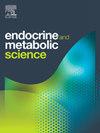Sleeve gastrectomy and pancreatic omentoplasty decrease insulin resistance: Impact on pro-inflammatory and anti-inflammatory cytokine gene expression
Q3 Medicine
引用次数: 0
Abstract
Background
Chronic systemic inflammation in obesity impairs insulin sensitivity and contributes to insulin resistance. Laparoscopic sleeve gastrectomy results in substantial weight loss and improved diabetic status, although 25 % of patients do not achieve optimal insulin production due to pancreatic fat accumulation. Addressing pancreatic inflammation is essential for better glycemic control. Pancreatic omentoplasty may enhance vascularization and reduce inflammation. This study examines the effects of sleeve gastrectomy and pancreatic omentoplasty on insulin resistance by analyzing the gene expression of pro- and anti-inflammatory cytokines and their correlation with HOMA-IR values.
Method
An experimental study with post-test only control design was conducted with obese and type 2 diabetes mellitus (T2DM) rat subjects which underwent sleeve gastrectomy treatment (SG), a combination of pancreatic omentoplasty and sleeve gastrectomy (SG + PO), without any intervention or a positive control group (+control), and rats which were neither obese nor T2DM or a negative control group (−control). On day 10 after surgery, blood samples from the rats were taken to assess blood glucose and insulin level in order to calculate HOMA-IR. Then, the pancreatic tissue of each rats was taken to extract the mRNA of TNF-α, IL-1, IL-6, and IL-10 by reverse-transcription polymerase chain reaction.
Result
The expression of the pro-inflammatory cytokine TNF-α in the SG + PO group was lower compared to the SG group (p = 0.008), IL-1 in the SG + PO group was lower than in the SG group (p = 0.043), and IL-6 in the SG + PO group was lower compared to the control group (p = 0.001). In contrast, the anti-inflammatory cytokine IL-10 was higher in the SG + PO group compared to the SG group (p = 0.001). Additionally, HOMA-IR in the SG + PO group was lower compared to the SG group (p = 0.001).
Conclusion
The combination of sleeve gastrectomy and pancreatic omentoplasty reduces pro-inflammatory cytokints (TNF-α, IL-1, IL-6) and increases anti-inflammatory cytokine IL-10, compared to sleeve gastrectomy alone. It also significantly lowers insulin resistance (HOMA-IR), suggesting that the combined procedure improves insulin sensitivity and glycemic control, cytokine modulation.
袖式胃切除术和胰网膜成形术降低胰岛素抵抗:对促炎和抗炎细胞因子基因表达的影响
背景:肥胖的慢性全身性炎症损害胰岛素敏感性并导致胰岛素抵抗。尽管25%的患者由于胰腺脂肪堆积而不能达到最佳胰岛素分泌,但腹腔镜袖胃切除术结果显著减轻体重并改善糖尿病状态。解决胰腺炎症对于更好地控制血糖至关重要。胰腺网膜成形术可增强血管化,减少炎症。本研究通过分析促炎性和抗炎性细胞因子的基因表达及其与HOMA-IR值的相关性,探讨了袖胃切除术和胰网膜成形术对胰岛素抵抗的影响。方法对肥胖合并2型糖尿病(T2DM)的大鼠进行实验研究,采用试验后对照设计,在不进行任何干预的情况下,分别采用袖式胃切除术(SG)、胰网膜成形术联合袖式胃切除术(SG + PO)和非肥胖、非T2DM大鼠及阴性对照组(−对照组)。术后第10天,取大鼠血样评估血糖和胰岛素水平,计算HOMA-IR。然后取各组大鼠胰腺组织,采用逆转录聚合酶链反应提取TNF-α、IL-1、IL-6、IL-10 mRNA。结果SG + PO组促炎细胞因子TNF-α表达低于SG组(p = 0.008), IL-1表达低于SG组(p = 0.043), IL-6表达低于对照组(p = 0.001)。相比之下,SG + PO组抗炎细胞因子IL-10高于SG组(p = 0.001)。此外,SG + PO组的HOMA-IR低于SG组(p = 0.001)。结论与单用套筒胃切除术相比,套筒胃切除术联合胰网膜成形术可降低促炎细胞因子(TNF-α、IL-1、IL-6),增加抗炎细胞因子IL-10。它还显著降低胰岛素抵抗(HOMA-IR),表明联合程序改善胰岛素敏感性和血糖控制,细胞因子调节。
本文章由计算机程序翻译,如有差异,请以英文原文为准。
求助全文
约1分钟内获得全文
求助全文
来源期刊

Endocrine and Metabolic Science
Medicine-Endocrinology, Diabetes and Metabolism
CiteScore
2.80
自引率
0.00%
发文量
4
审稿时长
84 days
 求助内容:
求助内容: 应助结果提醒方式:
应助结果提醒方式:


